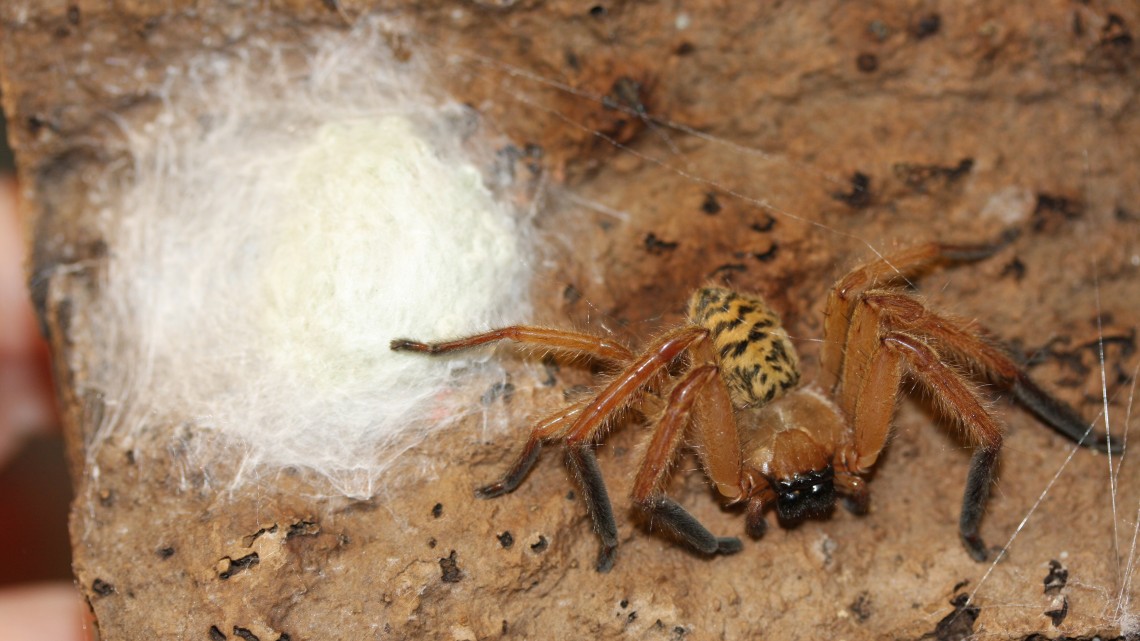
The Australian huntsman (Delena gloriosa) and her plastered egg sac.
Analysis of huntsman spiders reveals patterns of social behavior
By Krishna Ramanujan, Cornell Chronicle
A new study of huntsman spiders links evolutionary lineages with life history traits, providing patterns for predicting social behaviors in other less-studied species. Sociality is very rare in spiders – only five out of close to 1,300 huntsman species are known to exhibit social behaviors.
The study, “Huntsman Spider Phylogeny Informs Evolution of Life History, Egg Sacs and Morphology,” published June 2 in the journal Molecular Phylogenetics and Evolution, was part of the undergraduate thesis of lead author Jacob Gorneau ’20.
It represents the broadest and most in-depth phylogeny of huntsman spiders – a tree-like diagram showing evolutionary relatedness among groups of organisms – while incorporating extensive biology and life history data for each species. Compared with solitary species, the findings reveal, the social species live in larger permanent family group retreats until the offspring are up to a year old, have egg sacs plastered to surfaces so they can’t be moved and begin foraging later in their development.
“The social species are doing something different than all the other solitary species,” said Linda Rayor, the paper’s senior author and a senior research associate in the Department of Entomology in the College of Agriculture and Life Sciences (CALS).
“What makes this a landmark study is that we have incorporated behavioral and life-history traits on huntsman that I’ve been collecting for the last 20 years from both social and solitary species,” she said.
Huntsman spiders (Sparassidae family) are fairly common throughout the tropics and subtropics worldwide. They are also extremely diverse, with Sparassidae, the 11th largest spider family, dating back 100 million years.
The known social species span two genera and include four from Australia (Delena cancerides, D. lapidicola, D. melanochelis, and D. spenceri) and an unidentified species (Damastes) found in Madagascar. These social species live in large family groups with a single mother and multiple clutches of her offspring in retreats under the loose bark of dead trees or under rocks. The growing offspring remain in their natal retreat for five to twelve months, depending on the species.
The social species were also found to have egg sacs plastered to the back of retreats, so they couldn’t be moved, all of which promote living socially over extended periods in family groups. In contrast, the solitary species are more mobile and don’t have large, long lasting retreats, so offspring don’t remain with their mother for longer than a few weeks.
It is estimated that at least 1,000 huntsman species remain to be described. Anecdotal evidence suggests other species in various parts of the world may also be social, as researchers have witnessed mother huntsman spiders living in retreats with many instars (phases of larvae development) of offspring that share prey.
“There are probably a number more of these relatively social huntsman spiders, and this study provides a guide to look for similar life-history traits to see if they are also social,” Rayor said.
In the study, the researchers analyzed 271 spiders (262 were huntsman spiders, and nine were other kinds of spiders used for comparison), covering 37 genera and eight of the 11 sparassid subfamilies and included life history data for 40 species, based on laboratory and field observations collected by Rayor between 2002 and 2021. Gorneau also sequenced four genes to provide a well-rounded picture of huntsman spider evolution.
“Some genes evolve more quickly and are good for examining differences between more closely related species, while some genes evolve more slowly – are more conserved – and are better for understanding evolutionary relationships between groups of species that may be more distantly related. So we selected four genes that struck the right balance,” said Gorneau, who worked in Rayor’s lab and in the lab of co-author Corrie Moreau, the Martha N. and John C. Moser Professor of Arthropod Biosystematics and Biodiversity and director and curator of the Cornell University Insect Collection.
In future work, Rayor and colleagues are planning a comparative analysis of prey-sharing in 29 social and solitary huntsman species that will use this new phylogeny.
Cristina Rheims, a biologist at the Instituto Butantan in São Paulo, Brazil, is a co-author.
The study was funded by the National Science Foundation, the President’s Council of Cornell Women, the São Paulo Research Foundation, a Jane E. Brody Undergraduate Research Award, the Fredric N. Gabler ’93 Memorial Research Endowment and the CALS Alumni Association Academic Enrichment Program.
Media Contact
Get Cornell news delivered right to your inbox.
Subscribe
